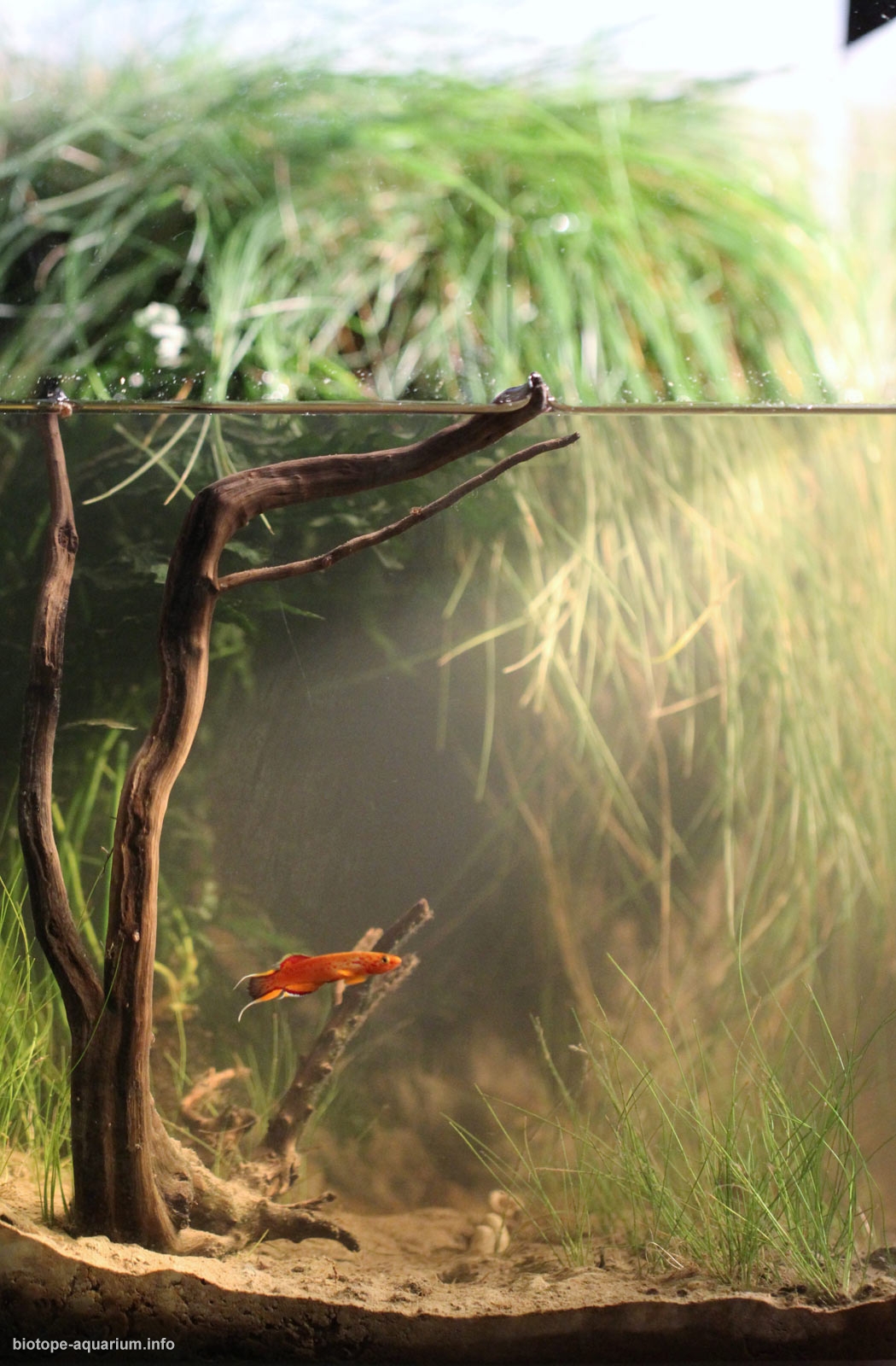Killifish “hole” on a flooded meadow, Wonga Wongue Reserve, the Ogooue basin, Gabon
54th place in Biotope Aquarium Design Contest 2017
![]() Russia. Natalia Sokolova
Russia. Natalia Sokolova

Volume: 20 L
Dimensions: 47x24x32 cm
List of fishes: Aphyosemion australe, Epiplatys annulatus, Atya gabonensis. Instead of the common species of Epiplatys, in the aquarium there is Epiplatys annulatus, which usually lives slightly south of Gabon, as they were available. Together with the killy in our aquarium there is a filter shrimp. This is not a typical biotope for it, but in nature it could also reach a meadow during the high water period, when it migrates from the ocean to the mountain streams. In the aquarium, it almost always hides deep in the “hole”, goes out “on the hunt” only at night and only in the early morning you can find it in the open space, waving its fans. But the bright light immediately makes it go home. Instead, a water scorpion would fit better, but it is not suitable for an aquarium, as it will too soon remain the only inhabitant.
List of plants: Agrostis capillaris, Eliocharis parvula, Bolbitis heudelotii. A. capillaris is used as a similar analogue of African savanna grass.
Description of decorations: Ground and turf are taken from a nature biotope of a similar type, the decoration is made by hand, the driftwood is UDeco.
Description of equipment: Aquael Fan Filter Mini, Aquael Easy Heater, AquaEl LED LEDDY TUBE DECOLIGHT SUNNY 6W.
Water parameters: Water temperature is 21-23°C, pH is 6.5, GH is 3 dH, KH is 2 dH, NH3 / NH4, NO3 is 0.
Description of the area surrounding the biotope: Wonga Wongué reserve is a Presidential Reserve, a nature reserve. It is located in the Central African state of Gabon, between the capital Libreville and the largest port of Port Gentil, at the intersection of the provinces of Estuare, the sea Ogooue and Moyen Ogué a little. It is located 100 km to the south of the equator and occupies 3850 km². Its height above sea level is up to 1500 m, the annual amount of precipitation is about 2000 mm. Coordinates of the reserve: Latitude: 0°25 ‘(0.4167°) south. Longitude: 9°30′(9.5°) east. The area is covered by extensive coastal savannah on vast tracts of classical rainforest. The main river is Ogooue, a large part of the country’s territory belongs to its basin. The river network is very dense and abundant. A lot of lakes, rivers and marshes cover the plains of the savannah during the rainy season. The climate is hot and humid. By the amount of precipitation there are two relatively dry (May-September and December-January) and two rainy seasons. Average monthly temperature is from 22°C to 24°C in July and from 25°C to 27°C in April, in the southeast in the hot months it exceeds 32°C. The average annual precipitation is 1500-2000 mm per year, in the north of the coastal strip it is up to 2500-4000 mm.
Description of the underwater landscape of the biotope: The clay and sandy soils of the savannah are covered with a fairly dense grass carpet, which partly burns out during the dry period, and is flooded during the rainy season. The bottom is covered with a thick layer of silt. Driftwood, rocks, bones of animals are found in some places. Plants are mainly represented by grasses, and also some species of semi-aquatic plants (dimorphs) are found in some places. All herbs usually grow in turf. The leaves of the cereals are dry and narrow, stiff and covered with a waxy coating. In the aquarium there is a natural hole in the meadow, perhaps the original trace of an elephant, which is filled with water only during the rainy season, in it killy-fish generations live. We see the biotope at the heigh season, when the grown-up Afiosemions are preparing for spawning. We also see little clown killies, they hatched six months later and are just starting their journey. In nature, too, it often happens that in a drying reservoir in one season there are more representatives of one species, and in the next representatives of another one hatch. They are fighting for existence, trying to force each other out into the most open spaces, where the chances of survival are reduced: they can be eaten by numerous birds and reptiles.
Description of the parameters of the habitat: The water has light amber color (peat), no flow, GH is 2-10 dH, pH is 6-7.5, KH is 5-13, salt is possible.
List of fishes: Aphyosemion australe, Aphyosemion simulans, Aphyosemion batesii, Aphyosemion kunzi, Aphyosemion cameronense, Epiplatys sexfasciatus, Epiplatys esekanus, Epiplatys sangmelinensis, Epiplatys berkenkampi, Epiplatys biafranus, Epiplatys grahami, Procatopus nototaenia, Nepidae.
List of plants: Pinnisetum purpureum, P. benthami, Adansonla digitata, Acacia albida, Baldellia ranunculoides, Bolbitis heudelotii, Anubias afzellii, Ottelia muricata, Eleocharis parvula.
Threats to the ecology: In this area, the wetlands of Ogooue near the Wonga Wongué Reserve, UNESCO offers to organize a “Biosphere Reserve”, so the variety of water flora and fauna is so great, but unfortunately, not the whole territory yet has received the status of a national park.
Sources of information: the killi exhibition in ecological and biological centre “Krestovsky ostrov” in January 2017; http://www.killi.ru/; Colour Atlas of Cyprinodonts of the Rain Forests of Tropical Africa, A. C. RADDA, E. PURZL; video; website; Reptiles and national parks in Gabon,Western Central Africa by Olivier S. G. Pauwels, Patrice Christy and Annabelle Honorez; article from the “Krugosvet” Encyclopedia; videos with biotopes: hole with killy; an elephant footprint; characteristic landscape for the killy biotope.
Comments of the members of the jury of Biotope Aquarium Design Contest 2017

Good idea with grasses, but Bolbitis is found in jungle areas, not in high light pools with shallow waters. I would like to see bigger aquarium (at least 50 litres) for this biotope.
